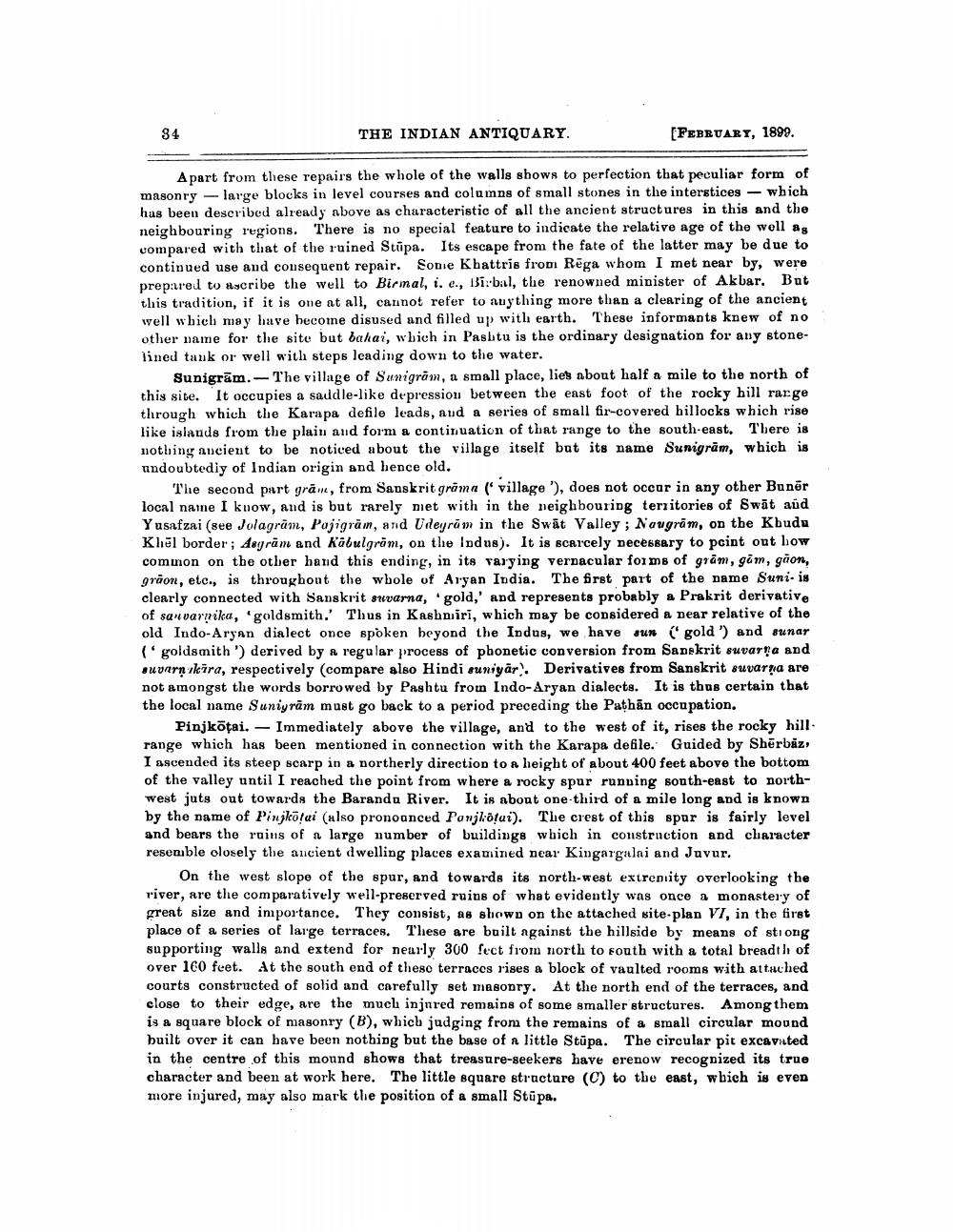________________
84
THE INDIAN ANTIQUARY.
[FEBRUARY, 1899.
Apart from these repairs the whole of the walls shows to perfection that peculiar form of masonry large blocks in level courses and columns of small stones in the interstices which has been described already above as characteristic of all the ancient structures in this and the neighbouring regions. There is no special feature to indicate the relative age of the well as compared with that of the ruined Stupa. Its escape from the fate of the latter may be due to continued use and consequent repair. Some Khattris from Rega whom I met near by, were prepared to ascribe the well to Birmal, i. e., Birbal, the renowned minister of Akbar. But this tradition, if it is one at all, cannot refer to anything more than a clearing of the ancient well which may have become disused and filled up with earth. These informants knew of no other name for the site but bahai, which in Pashtu is the ordinary designation for any stonelined tank or well with steps leading down to the water.
·
-
Sunigram. The village of Sunigram, a small place, lies about half a mile to the north of this site. It occupies a saddle-like depression between the east foot of the rocky hill range through which the Karapa defile leads, and a series of small fir-covered hillocks which rise like islands from the plain and form a continuation of that range to the south-east. There is nothing ancient to be noticed about the village itself but its name Sunigram, which is undoubtedly of Indian origin and hence old.
The second part gram, from Sanskrit grama ( village'), does not occur in any other Buner local name I know, and is but rarely met with in the neighbouring territories of Swat and Yusafzai (see Jolagram, Pajigram, and Udegrām in the Swat Valley; Naugram, on the Khudu Khel border; Asgram and Käbulgram, on the Indus). It is scarcely necessary to point out how common on the other hand this ending, in its varying vernacular forms of gram, gām, gāon, graon, etc., is throughout the whole of Aryan India. The first part of the name Suni- is clearly connected with Sanskrit suvarna, gold,' and represents probably a Prakrit derivative of sauvarnika, 'goldsmith.' Thus in Kashmiri, which may be considered a near relative of the old Indo-Aryan dialect once spoken beyond the Indus, we have sun (gold') and sunar ('goldsmith') derived by a regular process of phonetic conversion from Sanskrit suvarna and suvarn kira, respectively (compare also Hindi suniyär. Derivatives from Sanskrit suvarna are not amongst the words borrowed by Pashtu from Indo-Aryan dialects. It is thus certain that the local name Suniyram must go back to a period preceding the Pathan occupation.
Pinjkōtai. Immediately above the village, and to the west of it, rises the rocky hillrange which has been mentioned in connection with the Karapa defile. Guided by Sherbaz, I ascended its steep scarp in a northerly direction to a height of about 400 feet above the bottom of the valley until I reached the point from where a rocky spur running south-east to northwest juts out towards the Baranda River. It is about one-third of a mile long and is known by the name of Pinjkōtai (also pronounced Panjkotui). The crest of this spur is fairly level and bears the ruins of a large number of buildings which in construction and character resemble closely the ancient dwelling places examined near Kingargalai and Juvur.
On the west slope of the spur, and towards its north-west extremity overlooking the river, are the comparatively well-preserved ruins of what evidently was once a monastery of great size and importance. They consist, as shown on the attached site-plan VI, in the first place of a series of large terraces. These are built against the hillside by means of strong supporting walls and extend for nearly 300 fect from north to south with a total breadth of over 160 feet. At the south end of these terraces rises a block of vaulted rooms with attached courts constructed of solid and carefully set masonry. At the north end of the terraces, and close to their edge, are the much injured remains of some smaller structures. Among them is a square block of masonry (B), which judging from the remains of a small circular mound built over it can have been nothing but the base of a little Stupa. The circular pit excavated in the centre of this mound shows that treasure-seekers have erenow recognized its true character and been at work here. The little square structure (C) to the east, which is even more injured, may also mark the position of a small Stupa.




